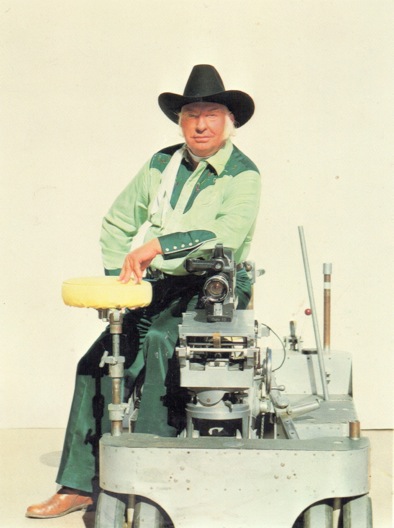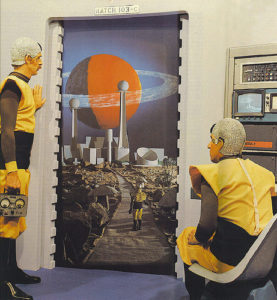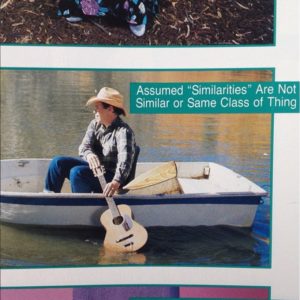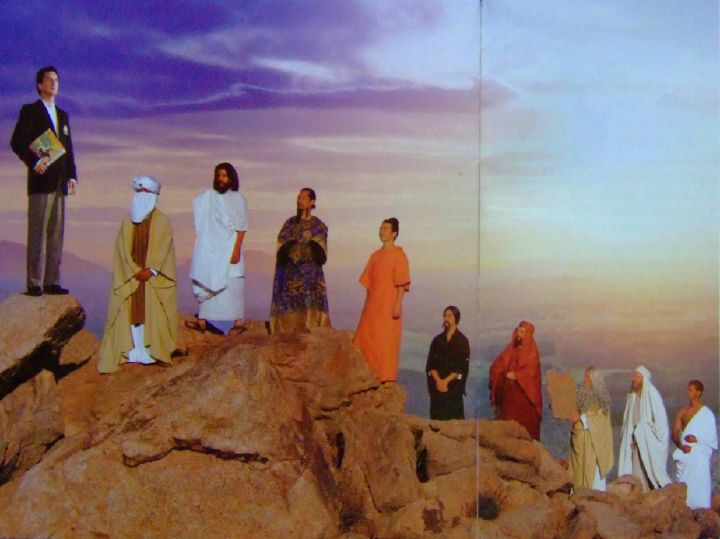This week, we look at L. Ron Hubbard’s laughable attempts to define “art” and to tell his followers how to create it. Some of what he says makes sense, when considered outside of Scientology, but when it’s taken inside the cult, the definition of art takes on a more sinister meaning. Today, we look at how Hubbard’s ideas of art are just another form of totalitarian control, sublimating the creative impulses many of us have in service to the cult and its leaders, just as many cults twist normal sexual behavior.
We also look at how Hubbard used the “Art Series” as just another dimension in trying to set himself up as the Smartest Guy Ever, an expert in everything. Of course, his theories of aesthetics are just as lame as his theories about physics (just how warm it is in the Van Allen belt, among many howlers), evolution (he believed in the Piltdown Man, long after it was widely suspected of being a hoax) and medicine (smoking cures cancer).

Between 1973 and 1980, Scientology founder L. Ron Hubbard wrote a series of HCO Bulletins laying down his definition of art, and expounded on the initial theory in 17 different documents. There’s no particular pattern to the docs, just a series of random brain farts published at equally random intervals over the course of 20 years.
| # | Date | Subject/Description |
| 1 | 8/30/1965 | Art |
| 2 | 7/29/1973 | Art, More About |
| 3 | 4/10/1974 | Stage Manners |
| 4 | 4/25/1974 | Rhythm |
| 5 | 9/26/1977 | Art and Communication |
| 6 | 12/30/1979 | Art in its Basics |
| 7 | 4/15/1979 | Fine Arts Versus Illustrations |
| 8 | 6/10/1979 | A Professional |
| 9 | 1/12/1980 | A Montage |
| 10 | 8/25/1982 | The Joy of Creating |
| 11 | 1/2/1984 | How to View Art |
| 12 | 8/10/1984 | Artistic Presentation |
| 13 | 2/25/1984 | Depth Perspective |
| 14 | 2/26/1984 | Color |
| 15 | 2/26/1984 | Art and Integration (also published as Marketing Series 20) |
| 16 | 3/10/1984 | Message |
| 17 | 11/16/1989 | Art and Equipment (originally written in 1979) |
The Key Messages: What Hubbard Thinks Art Is
The basic theory laid down in “Art Series 1” (1965) is this:
Art is a word which summarizes the quality of communication. It therefore follows the laws of communication. Too much originality throws the audience into unfamiliarity and therefore disagreement, as communication contains duplication and “originality” is the foe of duplication. Technique should not rise above the level of workability for the purpose of communication.
So basically art is about communicating a message. And the rest of the Art Series makes it pretty clear that Hubbard’s idea of communication is that every viewer of the art should get the same message. In other words, the artist should be able, through his imagination and technique, control the thoughts of many different recipients.
So why does Hubbard think he should weigh in with his own theory of aesthetics? He says:
Art abounds with authorities. It was chosen because “that field containing the most authorities contains the least codified knowledge.” The obvious invitation is to answer the question and codify the subject. This has now been done… I have made a breakthrough at last in this matter. And I find it is applicable to what we are doing and therefore also has practical value… My incidental studies in the fields of photography and music materially assisted these discoveries.
In other words, the experts are actually idiots, and I, alone of the thousands of people who have tried to invent a theory of aesthetics have done so, because experts are idiots and I’m smarter than they are.
And here’s where Hubbard turns art into utilitarian propaganda. He then goes on to say:
The reduction of mass or time or impedimenta or facilities toward the ability to render a result is the exact measurement of how much technical perfection can be attempted. The rule is if one is being too perfectionistic to actually achieve a communication, reduce the mass, time, impedimenta or facilities sufficiently low to accomplish the communication but maintain the technique and perfection as high as is reconcilable with the result to be achieved and within one’s power to act.
No communication is no art. “Art for art’s sake” is a complete paradox as a remark.
So art only has value when it’s trying to communicate something. Creating for the sheer joy of it is not art, and thus is verboten. Art only in service of the message sounds very MiniTru and “1984.” We think the reason for trying to suppress the joy of creation as its own reward is all about setting the stage for sublimating the creative impulse into the need to serve the cult. We think Hubbard is trying to get artists to feel uncomfortable with being who they are here. Our view is strengthened by what Hubbard says next:
One studies art only if one wishes to communicate and the search for artistic perfection is the result of past failures to communicate. Self-improvement is based entirely on earlier lack of communicating. The search for freedom is either the retreat from past failures to communicate or the effort to attain new communication. To that degree then the search for freedom is a sick or well impulse. Searching for and discovering one’s past failures to communicate an art form or idea about it will therefore inevitably rehabilitate the artist. However, due to the nature of the Reactive Mind, full rehabilitation is achieved only through releasing and clearing.
In other words, you might be creating for good reasons or for sick reasons due to the wounds in your reactive mind. And of course, the only way to know for sure whether you’re doing art for healthy reasons or for some sick aberrated reasons is to do Scientology. You wouldn’t want to be creating all that beautiful art, thinking you’re doing things well, but be doing it for all the wrong reasons, wouldn’t you? And you need Scientology not only to figure out whether you’re sick when you’re communicating but in trying to understand the receiver of the communications your art must include:
Artists all, to a greater or lesser degree, need comprehension of the minds and viewpoints of others in order to have their work accepted; since the acceptability of a communication depends upon the mental composition of the receiver. Scientology then is a must for any artist if he would succeed without heartbreak.
So by the end of Art Series 1, the trap is laid: Hubbard has redefined art and created the sense of uncertainty that you can’t be doing it right if it’s not utilitarian communication, and you can’t do communication right without Scientology. He’s replaced the reasons other people create art with insecurity that only he can cure. This won’t bring many people into the cult, but it will help keep those in the cult who are trying to do art according to his rules stuck.
Scientology Creating Art Via Hubbard’s Principles

Scientology’s attempt to create “art” for its own publications, using Hubbard’s mandate to communicate, were often pretty laughable. The training films are bad, but the print magazine articles are worse. We’ve tracked down just a few of the thousands of examples of Hubbard’s “creativity” floating around the internet. In this scene from the planet “Mothar,” two Scientologists dress up as aliens.
Given Hubbard’s perfectionism, this one throwaway scene probably took days and many tens of thousands of dollars to shoot. While professional artists and photographers of the time were creating groundbreaking work such as Star Trek that endures in its appeal a half century later, Hubbard’s photography in service of Scientology looks clownish and juvenile. We think it’s because he tried to literalize the display too much. It would have been better to leave the scene to the imagination, perhaps just by using only the matte painting in the background through the doorway.
One can only imagine the tense drama on the set as Hubbard sat there in his director’s chair, with Commodore’s Messengers holding his ashtray and bringing him cool drinks while he dithered over every detail and barked contradictory orders to confused and cowed staff.

And one can only imagine how the staff had to engage in all sorts of thought stopping exercises to try to convince themselves that a result like the photo to the left, captioned with a nonsensical bit of Hubbardian pseudo-philosophical nonsense must have had to engage in. How could they have rationalized dozens of people spending weeks to come up with this tangible illustration of “Assumed ‘similarities’ are not similar or same class of thing? A verbal example in the text would have been sufficient to explain that a guitar and a kayak paddle are similarly shaped but aren’t interchangeable.
In Art Series 6, Hubbard tries to answer the question about whether photography is art. He says, “Incidental to this, one can ask if a photograph can ever be art, a controversy which has been raging for a century or more. One could say that it is only difficult to decide because one has to establish how much the photographer has contributed to the “reality” or “literalness” in front of his camera, how he has interpreted it, but really the point is whether or not that photograph elicits a contribution from its viewer. If it does, it is art.” Too bad he doesn’t really take his own advice, as in the shot below.

Why This is a Cult Control Mechanism That Doesn’t Really Involve Art
Essentially, the reason for trying to create a definition of art and then to enforce that among both his organization and his followers is an attempt to find yet another way to control followers. The sheer number of ways that Scientology exerts control over members’ thoughts and behaviors is what makes it one of the most difficult cult experiences to escape. Over time, all cults attempt to do this; Scientology is more successful than most. We noted recently that Nxivm attempted to control children’s lives with a quack language immersion program and that paranoid political cultist Lyndon LaRouche attempted to wrest control of music from composers by redefining the centuries old tuning frequencies that all music is based on.
Essentially, controlling the creative thought process is one of the deepest and widest-ranging forms of control one can secure over the mind of a recruit. It’s up there with control of other fundamental human urges such as food and procreation. Scientology doesn’t typically restrict food among rank-and-file members, though Sea Org workers are given poor-quality food such as rice and beans as a way of eroding their self-respect, essentially reminding them that their failure to clear the planet necessitates such money-saving measures as the cheapest possible food to keep them alive. Serving leftovers and seconds for those being punished, such as inmates on the now allegedly abolished RPF program, is a way of humiliating people into compliance.
And Sea Org restrictions on sex outside of marriage is a way of channeling sexual and romantic urges. The need to get cult approval for marriage among staff, not to mention the social pressure against having kids (and the forced abortion policy now being litigated in Laura DeCrescenzo’s lawsuit) is control of one of the most fundamental biological urges.
We’d argue that the need to create is as primal for many people as the need to eat and procreate, so the cult is clearly trying to harness and sublimate all of the most fundamental human urges, getting people to give up their freedom and to overcome their desires, all in service of the cult’s goals.
When It’s All About Hubbard’s Brilliance
Of course, Art Series 1 kicked off the ego burnishing for “Source” by announcing that Hubbard alone has discovered the true meaning of art where philosophers have failed to explain it for thousands of years. Only he has discovered the simple truth.
In Art Series 2, Hubbard name-drops yet again, implying that he was an integral part of the Greenwich Village art scene in some unspecified period in the past: “Well, when I used to buy breakfasts for Greenwich Village artists (which they ate hungrily, only stopping between bites to deplore my commercialism and bastardizing my talents for the gold that bought their breakfasts) I used to ask this question and needless to say I received an appalling variety of responses.” In other words, not only did Hubbard know more than the philosophers, he knew more than the artists themselves about what art was, since every one of his imaginary artist guests had a different answer to the question. The rest of Art Series 2 continues in this vein with even more names dropped and even more ridiculous tales of his brushes with artistic greatness.
We love how the Hubbard Life Exhibit at Scientology’s Hollywood facility reveres Hubbard’s ordinary talents as a photographer by showcasing the hundreds of pieces of camera equipment that the great man used in his career redefining the state of the art in photos.

All that equipment, lovingly preserved, was necessary to give us such masterpieces as this:

In Art Series 4, the entire document is about rhythm. Basic facts are laid out, but the fact that this is an HCO bulletin that all staff and auditor trainees are required to study (it’s part of the “red volumes” after all) is just another example of Hubbard’s taking simple trivia and elevating it to holy writ. Once Hubbard has laid out the basics, he then tries to show off his brilliance by making rhythm something incomprehensible. He says, “When one changes rhythm within a single work one ‘makes wrong’ because the person has predicted the rhythm but the prediction is not met. Thus he is wrong. If the rhythm recurs, the person is made right.” Uh, OK. Changing time signatures is somehow evil? That essentially invalidates most of jazz and progressive rock classics of the 1970s (watch Bill Bruford of Yes and Neal Peart of Rush and even Danny Seraphine of Chicago, who are masters of complex time signatures and tell us that they are making their audience wrong).
Art Series 10 is a mercifully brief meander on “the joy of creating.” Here, Hubbard tries to shore up his “Mankind’s greatest friend” image of the genial grandfather, saying such Hallmark wall poster pleasantries as “Force yourself to smile and you’ll soon stop frowning. Force yourself to laugh and you’ll soon find something to laugh about. Wax enthusiastic and you’ll very soon feel so. A being causes his own feelings. The greatest joy there is in life is creating. Splurge on it!” I’m sure those banished to the RPF because they didn’t create the films and photo shoots in Hubbard’s imagination would agree that their lives could be made much better by forcing themselves to laugh.
Art Series 13 is a short bulletin all about “depth perspective.” Hubbard lays out a number of ways to make 2-dimensional works seem 3-dimensional, surveying 500 years of perspective in Western art. The advice isn’t bad, but it has a few bits of advice on technique that are real howlers, like “Depth by focus. Things when quite near are sharp. Things that are far are a bit blurry. Sharp sun gives you sharp detail. In photography, for soft focus, put a little spiral of Vaseline in the middle of the lens.” One can only imagine how the contractors producing dreck for Scientology TV are required to use Vaseline on expensive lenses because Hubbard said so instead of using modern techniques for soft focus, just as staff continue to clean windows today using newspaper and vinegar, as Hubbard laid down 60 years ago in one of the thousands of policy letters out there.
Miscellaneous Art Series Brain Farts
Art Series 2: Hubbard once again trashes “wog experts,” saying that “One is at liberty of course to challenge that wide purpose of art. Some professors who don’t want rivals tell their students ‘Art is for self-satisfaction’ [or] ‘It is a hobby.’ In other words, don’t display or exhibit, kid, or you’ll be competition! The world today is full of that figure-figure.” In other words, experts are so insecure in their “control” over the field of art that they constantly have to be afraid of amateurs taking over their control. Once again, Hubbard’s building up the ego of his members as a group: we Scientologists can take over the world in a triumph of enthusiasm over ability. When that of course fails, the answer is more auditing and more Scientology so that the members can figure out how they “pulled in” their failure.
Art Series 3: Hubbard talks about “stage manners” with some banal advice that he turns into a commercial for the “ARC triangle,” a teaching from lower-level Scientology courses that attempts to define the conditions for communication. Performing on stage falls under Hubbard’s definition of art, where it’s all about the precise communication everyone is supposed to receive. And as we know, Hubbard was a humorless sod where his own image and that of Scientology was involved. Here, among some trivial but correct advice about presentation skills, Hubbard slips in the need to be deadly serious: “None of this means that one cannot clown, joke, act superior or even seem austere. these are the arts of presence. But even in doing these, Stage Manners are observed.”
In Art Series 5, Hubbard slides in some anti-avant garde comments. He says “some avant-garde schools go completely over the cliff in avoiding anything “literal” or “common” – and indeed go completely out of communication!” This trashing of abstract art is common in high-control groups, and we’ll look below at some masters of controlling populations by positioning non-representational art as inferior.
Art Series 6 says: “Every separate sector of artistic creations has its own basic rules. Such areas include writing, painting, lighting, camera work, costumes, sets, marketing, recording, mixing – every contributory sector to a final art offering. Each one of these areas has basic stable data which govern it.” Hubbard would have done well to heed this advice in his laughable foray into redefining recording technology with the “clear sound” technique.
Art Series 11 is called “Artistic Presentation.” It has little do with that and everything to do with laziness of the “wog” world. “We live in a machine world. The whole yap of TV and newspapers is directed toward reducing effort. The primary goal of the civilization in which we live, it seems, is to reduce all personal effort to zero. The less effort a being can confront, the more effect of effort he becomes.” In other words, “the wog world is becoming so lazy that it will ultimately collapse. Only we hard-working Scientologists can save them.” This is exactly the point of all those North Korean propaganda posters exhorting people to meet their vegetable production quotas for the glory of the state.
Other High-Control Groups Defining Art Dogmatically
Totalitarian Groups
One of the best example of how high-control groups take art and turn it into low-grade dreck are the North Korean and Russian propaganda posters. In some cases, fine artists were dragooned into creating these posters; in others, nameless graphic designers did the job.
Above, one of an endless series of propaganda posters shows North Korea vanquishing the US. This sort of “art” certainly fits Hubbard’s criteria, because it communicates an explicit message that is going to be relatively similar in the eyes of the receiver of the message. The caption, which undoubtedly says something like “Death to the capitalist running dogs!” leaves little room for aesthetic reverie or interpretation.
Compare that “hit ’em over the head” message with the Mona Lisa. Everyone agrees that it’s one of the greatest paintings ever, but few can agree on key points. What does the enigmatic smile mean? Is the picture even of Lisa or is it a gender-switched picture of Leonardo himself? There’s no single communication from the painting. But does that mean that the Mona Lisa is not art?
Other High-Control Religious Groups
Other high-control groups that create large amounts of art in the service of ideology end up with laughable specimens like Scientology’s bizarre art. The Jehovah’s Witnesses create tons of paintings to illustrate bible stories and other points of dogma. While Jehovah’s Witnesses may take away from these paintings one message, we think outsiders will get a very different communication. The communication we receive from much of the JW artwork is that the group is astoundingly literalist in their views. The elders at the top of the organization feel that their members need every single detail of every single lesson profusely illustrated (or acted out in videos).
We also take away from the JW publications a number of creepy and faintly unsettling messages. In the painting below, why are these JW’s smiling broadly when the world is being destroyed by God behind them, and 99.9% of the global population is being murdered sadistically by God just because they weren’t Jehovah’s Witnesses.

This sort of creepy literalism and unsettling implied messages has always been present in JW art. Below, a magazine cover from 1980 echoes the North Korean propaganda poster above, with God’s mailed fist destroying the unbelievers.

The mailed fist of vengeance is certainly a popular theme for high-control groups, putting themselves in positions of power over the rest of the world. We’ve often thought that the JW’s are a religion of revenge fantasies for the economically disadvantaged — in the US, the JW’s are the least educated and lowest-earning major religious denomination, which leads us to suspect that much of their Armageddon focus is revenge on everyone they think oppresses them.
Channeling Definitions of Art for Political Purposes
Politicians, more frequently at the conservative end of the spectrum, often attempt to create a definition of art in order to inflame their loyalists. One example was in the 1950’s, when Senator Joseph McCarthy held hearings to expose what he alleged (with inflated numbers) were major attempts by Communists to infiltrate institutions of American life.
McCarthy’s first target was the US State Department, which typically opposed the sort of militaristic posturing that McCarthy and others of his ilk wanted. He claimed to have a list of 205 avowed Communist Party members in the State Department. Had he actually possessed that many names and exposed them, it would have significantly affected America’s ability to conduct diplomacy for years.
McCarthy’s primary civilian targets were Hollywood figures and gays. While the anti-gay campaign received less press, thousands of gays were pressured to resign government positions. McCarthy’s anti-Communist rhetoric aimed at specific Hollywood figures destroyed numerous careers of screenwriters and directors who may have at most had a brief flirtation with Communist ideas, but who fell far short of an active conspiracy to undermine the US government.
Of course, the most notable example of the attempt to redefine art as a means of political control came in the early Nazi era, when most avant-garde art was outlawed. Not only were thousands of pieces of art removed from museums (much of which was lost and potentially destroyed), but various musical forms including jazz were banned. Ultimately, modernist art was tied to Jewish corruption of the purity of Aryan culture, and it turned into yet another justification for oppression of Jews.

While Scientology’s attempt to define art for its members fell far short of what the Nazi’s did in the wake of their redefinition of art, it is worth remembering that totalitarian groups often serve a much more evil agenda by trying to regulate how people create and experience art. We can only speculate what Scientology would have done had Hubbard done more to regulate art in his members’ minds than an occasional series of scribbles that formed only a small part of the cult’s corpus of sacred drivel.
